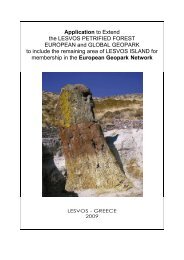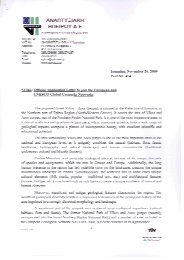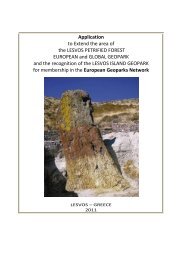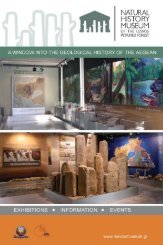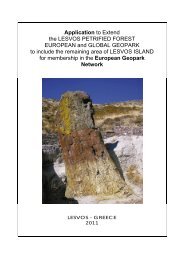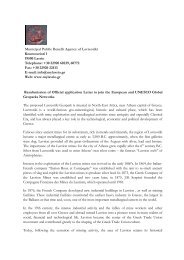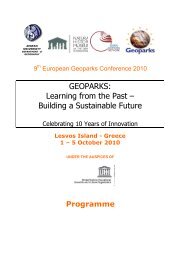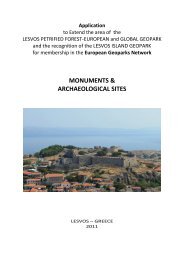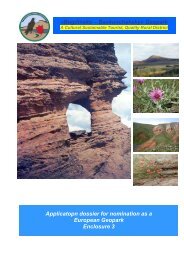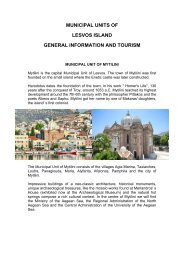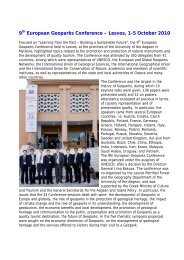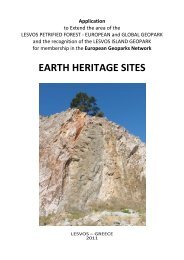monuments – churches – museums
monuments – churches – museums
monuments – churches – museums
You also want an ePaper? Increase the reach of your titles
YUMPU automatically turns print PDFs into web optimized ePapers that Google loves.
Application to Extend<br />
the LESVOS PETRIFIED FOREST<br />
EUROPEAN and GLOBAL GEOPARK<br />
to include the remaining area of LESVOS ISLAND for<br />
membership in the European Geopark Network<br />
LESVOS - GREECE<br />
2009
MONUMENTS <strong>–</strong> CHURCHES <strong>–</strong> MUSEUMS <strong>–</strong><br />
GASTRONOMY<br />
ANCIENT CHURCHES<br />
TEMPLE OF CLOPEDI<br />
The temple of Clopedi was first built in 8th b.c. Its final appearance was completed at<br />
6th b.c and the temple was encompassed with 46 columns having Aeolian capitals.<br />
Aeolian capitals of Taxiarches Troullotis in Napi, coming from the temple of Clopedi.<br />
Their main characteristics are the two big helixes.<br />
The arrow shape medieval bridge of "Cremasti" is saved while the liver Tsiknia was<br />
flowing below.<br />
TEMPLE OF MESSON<br />
The sanctuary of Messon is located at "Koukala" or "kokkala" of the Messa region, at<br />
the rural area of Agia Paraskevi in Lesbos. In antiquity it was situated at the north<br />
boundaries of the territory of the ancient city of Pyrra and in the middle (centre) of
the island of Lesbos with its name "Messon" originating from the Aeolic type of the<br />
word. The octastyle, pseudo-dipteral, ionic temple of the second half of the 4th<br />
century b.C. has integrated the archaic devotional building and its supplementary<br />
buildings. In the 3rd-4rth century A.D. the temple is destroyed, its architectural<br />
members smached and calcified in the kilns that were built adjacent to and around<br />
the temple.<br />
The basilica of the early Christian period is built on the floor of the late classical<br />
temple, while the cult continues at the same spot until today, where the post<br />
Byzantine church (naiskos) of Taxiarches is found. The Christian temples always<br />
had a cemetery by which is evident by the xcavated tombs found on he floor of the<br />
ancient temple and the surrounding area.<br />
"Αt the sanctuary situated in the middle of the island" the four cities of Lesbos,<br />
Mytilene, Methymna, Antissa and Eressus come together and take a common<br />
decision: for the augmentation and the union of the Lesbians:, according to an<br />
inscription dated around 200-167 B.C. In Messon, judges from Miletus come to<br />
resolve the differences of the two cities of Lesbos: Mythimna and Eressos.<br />
The panlesbian temple of Messon seems to share the same fate with the Koinon<br />
(commonwealth) of Lesbians from the archaic period until the 2nd century A.D.. This<br />
is the sanctuary identified with the "large temenos that can be seen from afar, for all<br />
the Lesbians" mentioned by the Lesbian poet Alcaeus. At this temple the Lesbians<br />
have established the altars dedicated to the "Immortal Blessed Gods" to Zus Antiaos<br />
(the Suppliant), to "the Aeolian Mistress, famed mother of all ", identified with HERA<br />
and to the "Kemelion", Omophage Dionysus", the so called Lesbian Triad. The same<br />
poet informs us about the annual celebrations and the beauty contests that took<br />
place at the temple.
The union of the five cities of Lesvos (Mytilene, Mythimna, Antissa, Eressos and<br />
Pyrra) especially during the period of the island;s liberation by Alexander the Great is<br />
expressed with the erection of a very important monument at the centre of the island,<br />
in Messon. In the beginning of 2nd century B.C. the temenos became more than a<br />
devotional place; It was also the seat of the Lesbian Koinon (Commonwealth), as<br />
well as th meeting point of the island and the place for exchanging ideas. In those<br />
years, the temple of Messon unites the Lesbians under religious, political, military<br />
and judiciary institutions.<br />
The ionic temple of Messon is one of the most important <strong>monuments</strong> of Lesbos.<br />
From the ancient temple only the foundations remain, with the interior of the<br />
crepida's tiers, while the niche of the temple of the early Christian basilica, along with<br />
the post-Byzantine church (naiskos) of Taxiarches can also be seen. The brittle<br />
material of the foundations' stones led the archaeologists to take immediate<br />
measures to protect it by covering it with a protective plaster.<br />
PALAEO <strong>–</strong> CHRISTIAN OF CHALINADOS<br />
The palaeo-christian temple of Chalinados was built in 550 - 600 a.C. The temple<br />
consists of three aisles and a narthex. The main temple is square with an arch at the<br />
east side.<br />
The aisles are separated with two rows of columns with anaglyph capitals.
MONASTERIES<br />
AGIOS RAPHAEL<br />
Settled at the N.E. side of the island, 3 km away from Thermi settlement, the<br />
monastery was built where an old Basilica Temple was. Remnants of the Basilica<br />
can be find at the area (frescoes, red tiled floor, the icon of Pantokratoras).<br />
We can see three periods: (α) from 10th century till 1235, (b) from 1433 up to 1463 -<br />
year of destruction from the Turks, with Agios Raphael as a monk and (c) from 1962<br />
till today. It is a monastery for women, built to honor to the Saint.<br />
It is one of the most important monasteries of the island and helps a lot to the<br />
economical development of the area.<br />
TAXIARCHIS MICHAEL<br />
It is a Byzantine monastery that was abandoned after the Turkish occupation (1462),<br />
while the temple was rebuilt in 1879.
Between the old items and icons of the monastery, there is the icon of Taxiarchis<br />
Michael, which according to the tradition was made by clay and the blood of the<br />
slaughter monks, that died during the distraction of the monastery by the Turks.<br />
The monastery is only a few kilometers away from the town of Mandamados.<br />
LEIMONOS MONASTERY <strong>–</strong> AGIOS IGNATIOS<br />
Leimonos Monastery was built at the centre of Lesvos island, 3 klm N.W. from<br />
Kalloni. The catholic part of the monastery is dedicated to Pamegistous Taxiarches.
It was built in 1523 by the metropolitan of Mythimna Ignatios Agalianos, his name is<br />
honored nowadays, while during the Turkish occupation was the only spiritual centre<br />
on the island. The Catholic is an imposing temple of Basilica style, with a wood<br />
curved temple and frescoes.<br />
It consists of a rich in books library while an Ecclesiastic art museum and Geological<br />
museum work (1990).<br />
MONASTERY OF VIRGIN MARY MIRSINIOTISSA<br />
This monastery was settled very close to Leimonos monastery, was reformed in<br />
1523 and was dedicated to Virgin Mary.<br />
Inside there are valiable icons, an old wood curved temple and important frescoes.<br />
MONASTERY OF PERIVOLI<br />
The Monastery of Perivoli is settled N.W. 3 km away from Antissa. Is a women<br />
monastery, dedicated to Theotokos (Virgin Mary), that reformed at the years of<br />
Turkish occupation (1630). Interesting are the icons of the wooden temple and the<br />
frescoes (16th century).
MONASTERY OF PITHARIOU<br />
The monastery of Pithariou is N.E. of Eresos (3 km). It is dedicated to Taxiarches<br />
and its foundation counts back to Medieval years.<br />
It is a Byzantine Monastery with valuable icons, ecclesiastic items and frescoes.<br />
MONASTERY OF IPSILOU<br />
Built at the top of the mountain Ordimos, between Antissa and Sigri, is dedicated to<br />
Agios Ioannis Theologos.<br />
The position that is built reveals that constructed in Medieval years (800 a.C). The<br />
Catholic is distinguish by the frescoes, while a number of valuable ecclesiastic items<br />
are kept inside.<br />
MONASTERY OF DAMANDRIOS<br />
Byzantine monastery (14th century), dedicated to Virgin Mary. Inside there are<br />
remarkable Byzantine technique and frescoes. Is 5km away from Polichnitos.
CHURCHES<br />
METROPOLITAN CHURCH OF AGIOS ATHANASIOS<br />
The Metropolitan Church of Agios Athanasios is in the centre of Mytilene. It was built<br />
at the 16th century, in a cross shape. It is dedicated to Agios Athanasios (saint<br />
Athanasios) and inside the church the sacred bones of Agios Theodoros are kept-the<br />
protector of the city.<br />
The wooden temple inside the church, is one of the best of the met Byzantine period<br />
(1738), and the icon of Jesus is a relic from Minor Asia (16th century).<br />
AGIOS THERAPON<br />
An imposing spot at the area of the port of Mytilene, is the biggest Church of the city.<br />
Built in 1860 in Byzantine cross style, while inside there are two remarkable icons, of<br />
Jesus (14th century) and Ioannis Theologos (15th century).
AGIOI THEODOROI<br />
ARCHANGEL GABRIEL<br />
It is one of the most ancient <strong>churches</strong> of<br />
Mytilene.<br />
It was constructed at the Byzantine era<br />
and rebuilt in 1759 in Basilica style, after a<br />
fire.<br />
Inside the church there are remarkable<br />
Hagiographies and Ecclesiastic items.<br />
It is 6 km south of Mytilene, at the area named Kagiani or Taxiarches.<br />
Built in 1903 in Byzantine style, cross shape, with a Gothic style dome. The temple is<br />
rich in sacred icons, items and frescoes and is an important prostration of the island.<br />
PANAGIA (VRGIN MARY) AGIASSOY<br />
Settled in Agiasos its name originates from an old icon of Virgin Mary, made by the<br />
Evangelist Louka, that according to the tradition the monk Agathonos brought in 803<br />
from Jerusalem that used to be called Agia Sion. The hermitage of Agathonas soon<br />
became a place of prostration that evolved to the development of town of Agiasos.
The church we see today was built in 1814. The church hostiles the Ecclesiastic<br />
museum with an important collection of scripts, items and other ecclesiastic things. It<br />
is an important prostration of the island.<br />
VIRGIN MARY GLIKOFILOUSA<br />
It is built on a rock in Petra area where 114 stairs have chased and lead to the<br />
church.<br />
This strategic place of construction has to do with the period of pirates' attack (post<br />
Byzantine era). Inside the church there are rare Byzantine icons and a spectacular<br />
Episcopal throne.<br />
This church is an important prostration for the island.<br />
VIRGIN MARY GORGONA<br />
It is built N.E. of Mytilene, 48 klm away, on a small rock in the sea, at the picturesque<br />
port of Skala Skamnias.<br />
The chapel took its name from the homonymous icon that represents Virgin Mary as<br />
a Mermaid (Gorgona in Greek) (work of art of an anonymous painter).<br />
CHURCH OF PANAGIA TROULLOTI <strong>–</strong> PIRGOI THERMIS
Built in the area of Pirgoi Thermis, at the eastern side of Lesvos island this church<br />
belongs to the category of basilica with dome and probably was built on 14th<br />
century. Is the oldest Orthodox Christian monument, after the monastery of Periboli,<br />
a monastery that is saved in Lesvos.<br />
On the walls of the church there are embodied parts of elder buildings. Great interest<br />
show 2 marble anaglyph at the southern wall of the narthex that adorned with human<br />
and animal figures (deer and bear), probably coming from the ancient church of<br />
Thermia Artemis.<br />
Inside there is a wooden temple (18th century) that is one of the best samples of<br />
Post Byzantine wood carving in Lesvos. Is dedicated to the Assumption of Virgin<br />
Mary and not to the Ruler of everything.<br />
CHURCH OF AGIOS STEFANOS MANDMADOS<br />
Settled at the eastern side of the island close to Mandamados. Is a cross style<br />
Basilica that constructed in post Byzantine era. Is a small church made of red color .<br />
At first was covered with a dome, that collapsed in the middle of 19th century. The<br />
roof reconstructed by the local people, by putting wooden rooftrees and tiles. At the<br />
eastern side there are three circled archades, while vaulting adorn the south and<br />
north wall. There are embodied architecture parts of an oldest temple and a roman<br />
sign.
CASTLES <strong>–</strong> MUSEUMS<br />
MYTILINI CASTLE<br />
Built at the top of a pine tree hill, close to the port of Mytilene, one of the biggest<br />
castles of Mediterranean.<br />
Its construction started during the Byzantine era (483-565 a.C.) and completed<br />
during the domination of Gatelouzi. (1355-1462). In 1373 built a multi-tower with<br />
dices. In 1384 a destructive earthquake demolished the castle that was rebuilt. Later<br />
was reinforced with defensive projects and in 1462 was seized by the Turks.<br />
Today the palace of Gatelouzi is saved, a square tower with embodied slate, where<br />
the blazon of Gatelouzi is performed. Also at the external gate there is a slate with<br />
the blazon of Paleologi. During the Turkish occupation made some additional works<br />
and a Turkish seminary was constructed, a building that is saved till today.<br />
Through the castle underground paths, that where used as a shelter for women and<br />
children of the city during the war and a water sink of 4.000 cubic meters.
Today is used as a place for cultural activities.<br />
CASTLE OF MYTHIMNA<br />
Built during the Byzantine era on the remnants of ancient, walls in order to defend<br />
themselves from Turks and Franks, and completed in 1373 from Francisco<br />
Gatelouso and reinforced by the Turks in 1462.<br />
It is a well - built castle, constructed with red and brown stones, with strong walls,<br />
signs, blazons e.t.c. The castle has many levels, while extremely beautiful<br />
monument is the central entrance made of thick wood, covered with fancy metal<br />
slates.
It was built at the top of a pine-trees hill and considered as one of the most well<br />
preserved castles of Eastern Mediterranean. Nowadays it is a place of cultural<br />
activities.<br />
SIGRI CASTLE<br />
It is a small stone castle, built at the Turkish occupation, sample of Ottoman<br />
technique. Built in 1757 or 1767 from Suleiman Pasha (vice admiral of the Ottoman<br />
Navy) in order to protect the commercial port from the pirates.<br />
It is quite small, square, with square supporting towers at the four corners. The<br />
central gate at the east side was closed with a two-door gate, with metal foils.<br />
Adorned with an arch - sample of Arabian architecture - constructed with red and<br />
white stones. Similar are the cells, inside the castle, that used for guards stay.<br />
Today the castle is preserved in a quite good condition. The visitor can admire<br />
Turkish signs and decoration, that show an Eastern character. It is a few kilometres<br />
far from the settlement of Sigri and has great view.
ROMAN AQUADUCT<br />
Settled about 600m away from Moria (6 klm away from Mytilene), is a unique stony<br />
construction from the roman era (second a.C. century) and was brought water from<br />
Agiasos to the city of Mytilene.<br />
Nowadays, the biggest part of the aquaduct is well preserved and it is named<br />
"kamares": 12 pessaries and 7 kamares made with grey marble, coming from a<br />
neighbor quarry.<br />
At the top was the water channel.<br />
The water used to gather from the lake of Olympos, while water was taken from<br />
other springs also. Other parts of the aquaduct are saved in many places of central<br />
Lesvos.<br />
The part in Moria is 170 meters long and 27 meters high, while has 17 arches.
MUSEUM OF THEOFILOS CHATZIMICHAIL<br />
It is settled in the area named Varia, outside Mytilene. A building of austere<br />
architecture, designed by the Lesbian architect Gianoulelli and built in 1964 in a<br />
region full of olive trees and plants. The building was a donation of Teriade, an also<br />
important artist of Lesvos Island. Inside the museum there are 86 paintings of the<br />
famous painter Theofilos, some of which were donated of Teriade, from his personal<br />
collection to the Municipality of Mytilene.<br />
Theofilos Chatzimichail, as a self educated painter, is the main representative<br />
of Greek pop art of 20th century. He was born (1868-1934) in Varia, a place<br />
where he spent his childish years and a place that he loved and expressed<br />
this love through his work. He knocked around, from Smyrni to Pilio and<br />
Larisa where he creates the first two periods of his painting. After the<br />
liberation of Lesvos Island (1912) he goes back to Mytilene so as to complete<br />
the third and the last period of his work. At this time he met Teriade, a man<br />
that helped him to become known and promoted him internationally.<br />
Theofilos art is represented by a great in quantity painting work and wall-painting
work (houses and shops) in Lesvos and Pilio. His themes were historical and<br />
sentimental mainly - express his two basic elements: patriotism and an inclination to<br />
romanticism. He takes inspiration from the history of Greek tribe, starting from<br />
antiquity till 1821, the year of Greek Revolution. Greek history gives him his heroes:<br />
Alexander the great, Kostantinos Palaiologos, Kolokotronis, Markos Mpotsaris e.t.c.<br />
From the novels takes the figures of Aretousa, Romeo and Juliet and many other<br />
women. We have to mention that a source of inspiration was the natural environment<br />
also. The Greek landscape and idyllic scenes follow his paintings.<br />
His art has all the characteristics of pure pop art: bright colors, authenticity,<br />
ingenuousness and honesty, elements that bring balance to some historic<br />
inaccuracies and technical clumsiness.The paintings that exposed in the<br />
museum belong to the mature period of his paintings where color harmony,<br />
realism and liveliness are joined. Soon in the city of Mytilene the visitor will<br />
have the ability to visit the house where the painter lived many years and will<br />
became a museum.
MODERN ART MUSEUM <strong>–</strong> TERIADE LIBRARY (ELEFTHERIADIS)<br />
It is very close to the building that houses the museum of Theofilos, in Varia. Stratis<br />
Elefteriadis was born in Mytilene (1897-1983), while in a small age goes to Paris,<br />
studies jurally but his love for painting leads him to became an art critic. He<br />
cooperated with publishers of his era in magazine and book editions, while in 1937<br />
initiates his own publishing company "VERVE", publishing the homonymous<br />
magazine, where many famous writers, painters and poets cooperate with him<br />
(copies of the magazine are exposed in the entrance of the museum. Teriade had<br />
the inspiration to encourage many artists-friends so as to publish "The great Books".<br />
While VERVE magazine was a reproduction of paintings, "The great Books" are<br />
originally, handmade, in a small number of copies (180-250), numbered and signed<br />
by the artist.<br />
The idea of an illustrated book is a result of his publishing experience and deep<br />
knowledge with painting and scripts of the Medieval. In 1964 offered to the<br />
Municipality of Mytilene the museum of Theofilos and later creates the Modern Art<br />
Museum, construct the building, a design of the architect G.Gianoulelli, in the same<br />
area where Theofilos museum is settled.<br />
In every room of the museum there is a showcase with "The great Books", while on<br />
the walls there are pictures and pages exposed to each visitor. The pages on the
walls are the final testing copies, before the printing of the book. Through these<br />
pictures the visitor can observe the creative try of painting-poetry. This was the<br />
purpose of Teriade and he managed to achieve this in so high degree that the<br />
museum could renamed to "Open Book".<br />
In the museum there are also 37 paintings of Theofilos, 6 paintings of Tsarouxis and<br />
three off Kaligiannis.<br />
ARCHAEOLOGICAL MUSEUM (OLD BUILDING)<br />
Placed in the area of south port of Mytilene it is housed in a wonderful mansion, built<br />
in 1912, in peculiar style, that is considered preserved. In the main building idols,<br />
ceramics and jewelry from the pre-historic to the Roman era are exposed. At the<br />
manor and courtyard heavy items such as aeolian capitals from the ancient temples<br />
of Clopedi, signs, anaglyph, statues and coins from the Ancient and Roman times<br />
are exposed. The museum houses the following collections: findings of the K<br />
department of Prehistoric and Classical Antiquities, findings from the cave of Agios<br />
Vartholomeos and exhibits from donations (Simantiris, Grimanis, Alatza, Lagou,<br />
Mpinou e.t.c.).<br />
ARCHAEOLOGICAL MUSEUM (NEW BUILDING)<br />
Housed in a very modern (1995) exhibition area close to the old building of the “old”<br />
Archaeological museum, the museum hostiles the permanent exhibition named<br />
"Lesvos from Hellenistic to the Roman era", initiated in 1999 and has as a purpose to<br />
show to the visitor the way of living in Lesvos from the 2d b.C. till 3d a.C., by<br />
showing items, utensils, sculptures e.t.c. The exhibition is completed with scripts,<br />
maps and other things so as the visitor to understand better the exhibits. The<br />
museum has tilled floor and frescoes from luxury villas that discovered to the hill of<br />
Agia Kiriaki - signs of the great economic development of Mytilene in 2d b.C. and<br />
remarkable samples of sculpture from Hellenistic and Roman times (anaglyphs,<br />
statues and portraits.
BYZANTINE ART MUSEUM<br />
It is settled at the centre of Mytilene, opposite to the Church of Agios<br />
Therapon, and was built in 1978. The museum houses important ecclesiastic items<br />
of the Byzantine and Post-Byzantine period. The exhibits are sacred utensils, wood<br />
curved items, scripts, old books e.t.c. The icons collection covers the period between<br />
the 13th and 19th century. Extremely impressing are 3 icons of big dimensions:<br />
Pantokratoras, Agios Ioannis Theologos and Agios Georgios.
PETRIFIED FOREST OF LESVOS<br />
At the Western part of Lesvos Island, there is the petrified forest, a unique<br />
monument of nature, of very important Geological, Environmental and<br />
Paleontological importance.<br />
Researches have proved that 20 million years ago volcanicity at the area of N.E.<br />
Aegean sea, caused the movement of volcanic material, that with an extremely great<br />
speed covered the forest, while the isolation of the phytogenic tissue from the<br />
surface, the hydrothermal circulation of warm silicon liquid, caused the absolute<br />
petrifaction of the flora in this area.<br />
Today, through the erosion of the volcanic stones, impressing trunks have revealed<br />
(20m width), while their diameter is about 3m. Excavations made by the Natural<br />
History Museum (1997) cooperated with the Lesvos Forests Management, have<br />
revealed findings with great scientific worth, such as the trunk of a petrified tree (<br />
Taxodioxylon albertense) that is the biggest in Europe ( 7,02m height, 8,58m<br />
perimeter).<br />
Other petrified trunks that belonged to bays, cypresses, sycamores e.t.c. are<br />
exposed to the museum.<br />
NATURAL HISTORY MUSEUM<br />
In 1985, the Greek State - with presidential enactment - proclaimed the Petrified<br />
Forest as a Preserved Monument of Nature, aiming to protect it. In 1994 a super-<br />
modern Museum was built, in order to protect, research and preserve the museum.
The building constructed with stonework made by grey lava as the major ingredient<br />
of the area.<br />
Next to the museum, a Petrified Forest Park was founded, where petrified trees and<br />
trunks are exposed to the visitors. The most important findings of the park are the<br />
roots of the petrified tree trunks.<br />
Roots and trunks with wonderful colors are coming into view through the volcanic<br />
ashes that encloses them.<br />
NATURAL HISTORY LAOGRAPHIC MUSEUM IN VRISA<br />
It is worthmentioning the existence of Natural History Collection in Vrisa where many<br />
paleontological findings are kept. These findings are of great worth for the whole<br />
world.<br />
In 1999 for the first time the World conference took place in Polichnitos and Vrisa<br />
and many famous scientists participated.
Dream of the local community is to initiate a branch of Athens University in Vrisa, for<br />
the development of scientific research and tourist development.<br />
In the same area the Laographic museum gives you the opportunity to admire many<br />
traditional items.
OLIVE OIL AND OLIVES<br />
Ancient Greeks used olive branches as the highest reward to winners of Olympic<br />
Games, while the oil was used for therapeutic reasons, beautifying, for illumination<br />
and nutrition. The fruit of the tree of victory and peace was used for the therapy of<br />
headaches, throat aches, ear pains, dislocations, fractures, wounds and as a means<br />
of rubbing medication, massage and as a medical plaster, as a disinfectant and a<br />
cosmetic, even as and antidote for poisoning. Olive oil is believed to help the<br />
development of the central nervous system and of the brain and has been proved of<br />
having beneficial properties with regards to heart related illnesses, cholesterol,<br />
constipation, gall-stone, indigestion and ageing problems.<br />
The ΄΄Gold Liquid΄΄ of Homer is the backbone of Greek nutrition from his era to ours<br />
and justifies victoriously with world wide success and proclaims the "Mediterranean<br />
Diet" as the most beneficial and healthy "diet system" that one might select. How and<br />
why olive oil together with bread, pulse, vegetables and fish contribute to such a<br />
nutritional triumph you will discover once you basically adopt such a diet and enjoy<br />
later the results in your body system. The virgin Lesbian olive oil is rich in single<br />
insatiable fatty acids as opposed to other seed-oils which basically have multi<br />
insatiable fatty acids.<br />
It is known the fatty acids in oil firstly affect the degree of oxidation when frying and<br />
then separate in unhealthy substances having bad odour. Olive oil has the<br />
charismatic identity to have special stamina to frying due to the natural anti oxidation<br />
contents allowing it to be used repeatedly without the fear of oxidation. With the use
of seed-oils for frying, not only do we effect the taste and odour of the food but the oil<br />
achieves health hazard identities.<br />
On the other hand the consistency of the organic characteristics of olive oil even<br />
after frying and cooking transfers a pleasant taste and aroma in our nourishment. As<br />
a result syntheses of the gastric fluids are modified and digestion is facilitated. The<br />
virgin olive oil of Lesvos which exceeds the colour of gold contains only a minimal<br />
amount of chlorophyll as a result of the traditional way of gathering of olives and their<br />
special variety.<br />
Thus our packed olive oil has better resistance to time because chlorophyll, when<br />
exposed to light speeds oxidation. This is the virgin olive oil of Lesvos, a natural thin<br />
liquid of the olive tree and a unique source of precious Vitamin E.<br />
At Lesvos island three species of olive trees thrive mainly: “Adrammytian”, “Kolovi”<br />
and “Roupada”. Eleven millions olive trees offer their valuable fruit which is famous<br />
all over the world. Olives! Green, crushed, half-ripened half-bitter and carved, stored<br />
in salt-water. Black wrinkled and salted from the basket or the jug and pickled,<br />
accompanied by slices of freshly cut lemon, necessary with ouzo drink at the fishtaverns!
OUZO OF LESVOS ISLAND<br />
Ouzo is a spirituous drink that is made only in Greece with traditional way, with<br />
aromatic plants of the Greek land. It is produced by the mixture of many alcohols,<br />
which have been flavored with aniseed and other aromatic plants such as fennel,<br />
mastic e.t.c. The proportion of alcohol that is produced in our island is between<br />
37.5% to 48% vol.<br />
A place so beautiful, like the land of Lesvos, that praised and became inspiration for<br />
poets, painters and writers, with plenty of sunlight and many types of aniseed, was<br />
natural to generate the production of ouzo.<br />
Ouzo of Lesvos has a 200 year history. Before 1800, ouzo is already known on the<br />
island. It is an eponymic product that is exported to the Eastern countries.<br />
Many of the distilleries that initiated and worked the last century did not make to<br />
"survive" and closed. The rest have a quite good profile in local market, while some<br />
of them managed to export ouzo and expand in Greece and the rest of the world.<br />
Ouzo is the traditional and the most favorite Greek spirit. Ouzo of Lesvos has its own<br />
personality, its own taste, its own legacy and secrets that are known to the
producers. These secrets have made ouzo a high quality product, either as Lesvos<br />
ouzo, or ouzo of Plomari.<br />
Is used as aperitif, plain or with water added. Usually is enjoyed with traditional<br />
delicacies such as fish, octopus and squid. Some people prefer to drink it with ice<br />
cubes as a long drink. Nowadays ouzo is a very famous drink all over the world.<br />
DAIRY PRODUCTS<br />
It is obvious that Lesvos island, maintains its traditional color and resist to<br />
innovations of contemporary life. The older and new generations remain faith to the<br />
traditional nutrition standards, increasing the demand of agricultural and cattleraising<br />
products.<br />
This inclination to the Greek way of life and nutritional way is comprehensible since<br />
all the dairy products of the island, preserve their quality (ladotiri, feta, kaser, e.t.c.).<br />
And this preference to the products is unchangeable, not only for the local<br />
consumers but for the rest of the country.<br />
Natural flora and the tribes of sheep-goats are the basic elements that give this<br />
perfect milk (fine composition)- that could by characterized as ecological- this milk<br />
process the cheese making units, by putting into practice traditions, knowledge and<br />
craftsmanship that passed from one generation to the other.<br />
Human factor is determinant to this unique tasty results, since their best quality is<br />
linked with the knowledge of the biotope, the way of feeding and the traditional way<br />
of cheese making.<br />
That is why we can enjoy the spicy taste of graviera, the freshness of feta and the<br />
mature sense of ladotiri.
SALTED FISH & SHELLS<br />
One of the main products of Lesvos island are the salted fish. When we say salted<br />
we mean fish that are proceeded and preserved only in salt, put up in various sizes<br />
of cans.<br />
In Lesvos municipality, work many small industries that proceed and can salted fish.<br />
Capability of conservation starts from 20 and can go up to 400 tones yearly,<br />
according to the makings of every industry and the production that bring the fish<br />
boats.<br />
Productive procedure becomes with an empirical way meaning that there is only one<br />
technique that is used for preservation and this is salt and no other ingredient.<br />
This procedure passes through the generations and becomes better and better.<br />
The way of production is traditional and is made only with hands not machinery.<br />
The kinds of fish that the small industries proceed are sardine, mackerel, cavalla,<br />
anchovy and salted tuna. The fishing starts from March and ends at October, apart<br />
from salted tuna that is found after October.<br />
The quality of these kinds of fish, in the marine area of Lesvos municipality, is very<br />
high due to the climate and the sea that is rich in food (plankton). We all know the<br />
famous sardine of Kalloni, smaller in size but very tasteful.<br />
Some consumers buy the sardines and tastes them with oil and vinegar as a dainty<br />
of high quality.
Another characteristic of the islands is the shells like oysters, scallops e.t.c. Is the<br />
natural wealth of Lesvos island. You can eat them fresh, row, with lemon or grilled.<br />
LESVOS WINE<br />
“At first was....” the seed of creation. Creation that exists in the human cells.<br />
Sometimes is transfered through generations and grow mature memories.<br />
Lesvos produces "Methimnaios Wine". Methimnaios was a name for the god of wine<br />
Dionysos. It is a product of lesbian vines that used to produce the most expensive<br />
wines of the antiquity. These kinds of vines grow nowadays on lava that was<br />
created-many years ago- by the Petrified Forest of Lesvos.
PASTA <strong>–</strong> SAUCES <strong>–</strong> BREADS <strong>–</strong> HARDTACKS <strong>–</strong> FLOUR<br />
The cultivation of cereals was wide spread in Lesvos Island. Flour is produced from<br />
cereals and in many villages and towns there were flourmills.<br />
Nowadays, the women cooperation's of the Municipality and small industries, make<br />
with traditional way pasta (of the best quality), such us spaghetti, lasagna, noodles<br />
e.t.c. that you will enjoy.<br />
Hardtacks, cookies and sops of every type can satisfy even the most demanding<br />
consumers, since the quality, the taste and the odor will enthuse you.<br />
Olive cookies, orange and cheese flavored cookies are some of the tastes that you<br />
will never forget.<br />
In Lesvos there are also produced wonderful sauses. Tasty and spicy! The best<br />
supplement for a plate full of spaghetti.<br />
Sauces are produced only from organic tomatoes, using traditional recipes coming<br />
from our grandmothers, and have extremely fine taste and essence.
TRADITIONAL SWEETS <strong>–</strong> MARMALADES <strong>–</strong> ALMOND SWEETS <strong>–</strong> LIQUEURS<br />
Municipality of Lesvos could not be absent from this section.<br />
Great development have to show the local Women Cooperations, consisted of<br />
women of the countryside that shaped cooperation's in order to make traditional<br />
sweets, marmelades and almond sweets with pure ingredients, fine scent and divine<br />
taste.<br />
Some of the sweets (contain 70% fruits, no preservatives, no chemicals) that are<br />
produced in Lesvos island are: Orange, lemon, tangerine, vine, cherry, apple,<br />
tomato, water melon e.t.c.<br />
Traditional Greek sweets like baklavas, nut- cake, cake with syrup, are made with<br />
recipes that the grandmothers told their daughters and grand daughters.
Tastes that give you the feeling of another era. Also liquors made from local juices<br />
are produced.<br />
Platseta, is a local sweet made with traditional way and has walnuts, sesame, syrup,<br />
spices.<br />
The famous macaroons, a wedding sweet with almonds and sugar are a few of the<br />
tastes that you have to eat!<br />
HONEY <strong>–</strong> PASTELI <strong>–</strong> HALVA <strong>–</strong> LOUKOUMIA<br />
Essences and only essences from thyme, myrtle, oleander, all the earth colors ans<br />
essences, compose this unique juice coming from bees, so as to taste it with bread,<br />
in baklava or in the wedding sweets.<br />
Nutritious worth is really great from ancient years and Hippocrates was<br />
recommended honey as a medicine for many diseases, since he believed that honey<br />
prolongs life.<br />
Nowadays Lesbian and Limnian producers preserve all the contemporary<br />
qualifications during procedure, so as to offer you in many types the pure, awarded,<br />
unique product, aiming to enthuse you with its taste.<br />
Lesvos honey has awarded with the “GREAT TASTE AWARD”. Basic ingredients<br />
are 20% - 30% thyme, 40% wildflowers, 15% osier and other fruits.
From honey and sesame pasteli is produced, pure and healthy food for children and<br />
adults.<br />
Halva is made after the procedure of sesame (taxini), without chemicals,<br />
preservatives or colors. So is one of the most pure and healthy foods in many tastes<br />
like cocoa, peanuts, honey, almonds e.t.c. Is also used as an antidote....after a lot of<br />
drinking!!!<br />
Loukoumia is a great recipe with sugar, glucose, amylum and essences and has<br />
become one of the favorite sweet temptations for everybody.!



